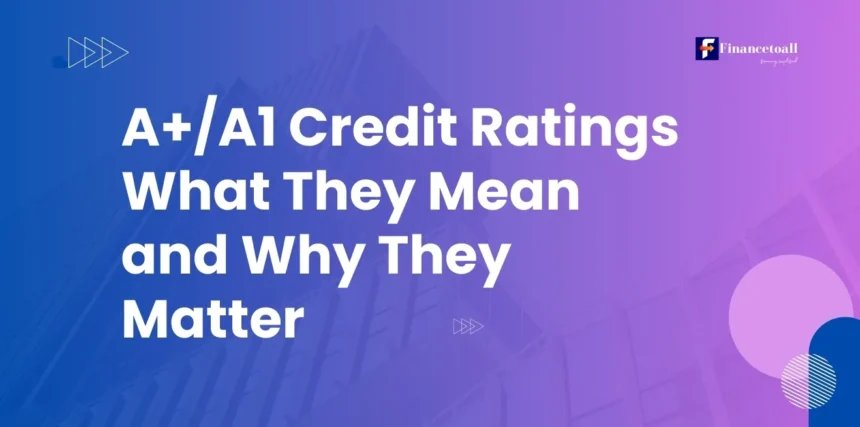A+/A1 Credit Ratings play a crucial role in the financial world, serving as an essential tool for investors, corporations, and governments to assess the creditworthiness of an entity. These ratings, issued by major agencies such as Standard & Poor’s, Moody’s, and Fitch Ratings, provide a snapshot of an entity’s ability to meet its financial obligations. Among these ratings, A+/A1 stands out as an important indicator of financial health. But what exactly do these ratings signify, and why are they so significant?
What is an A+/A1 Credit Rating?
Credit ratings are typically presented on a scale, ranging from the highest rating of AAA to the lowest of D. The A+ rating, which is equivalent to A1 in Moody’s terminology, is considered an upper-medium grade rating. This places it in the category of investment-grade ratings, meaning the entity has a strong capacity to meet its financial commitments but carries a slightly higher risk compared to higher ratings like AAA or AA.
Key Points About A+/A1 Ratings:
- Upper-Medium Grade: Indicates strong financial health and ability to repay debt.
- Low-to-Moderate Risk: While not the highest, it suggests relatively low credit risk.
- Investment-Grade Status: A+ or A1 ratings are attractive to a broad range of investors, including those seeking lower-risk investments.
Factors That Influence A+/A1 Ratings
The process of assigning an A+/A1 rating involves a comprehensive evaluation of several factors. Credit rating agencies consider both quantitative and qualitative aspects of an entity’s profile:
- Economic and Financial Health:
- The overall economic environment in which the entity operates, including GDP growth, inflation rates, and employment levels, directly impacts the rating.
- The entity’s financial health, including revenue generation, profit margins, and cash flow, is crucial.
- Debt Levels and Repayment History:
- Agencies assess the entity’s current debt levels relative to its income.
- A strong track record of timely debt repayment enhances the likelihood of a favorable rating.
- Political and Regulatory Environment:
- For sovereign entities, the stability and predictability of the political environment play a significant role.
- Adherence to regulatory standards is also considered, particularly for corporations.
- Market Conditions:
- Interest rates, exchange rates, and broader market trends can affect an entity’s ability to service its debt.
Implications of A+/A1 Ratings
An A+/A1 rating has several important implications for both the rated entity and its stakeholders. First and foremost, it boosts investor confidence. Investors view A+/A1-rated entities as relatively safe investments, leading to increased demand for their debt securities. This demand, in turn, allows the entity to borrow money at lower interest rates, reducing the overall cost of capital.
Impact on Financial Instruments:
- Lower Borrowing Costs: Higher ratings typically translate into lower interest rates on bonds and loans.
- Investor Confidence: Entities with A+/A1 ratings attract a broader range of investors, including institutional investors who often have mandates to invest in investment-grade securities.
- Market Perception: A strong rating enhances the entity’s reputation in the financial markets, often leading to better terms on future financing.
A+/A1 Ratings in Context: How Do They Compare?
To fully appreciate the significance of an A+/A1 rating, it’s helpful to compare it with other ratings:
- Higher Ratings (AAA, AA): These ratings represent the highest level of creditworthiness, with even lower risk than A+ or A1. Entities with these ratings are viewed as having an extremely strong capacity to meet financial commitments.
- Lower Ratings (BBB, BB): As we move down the scale, the risk of default increases. BBB is still investment grade but carries a higher risk than A+. BB falls into the speculative grade, indicating significant risk.
In addition to these ratings, credit rating agencies also provide outlooks—such as positive, negative, or stable—which indicate the potential direction of the rating in the future.
You Can Also Read About A Credit
Real-World Examples of A+/A1 Ratings
To put theory into practice, let’s look at some real-world examples. Large corporations like Johnson & Johnson or technology giants like Apple have historically maintained ratings in the A+ range, thanks to their strong financial performance, significant cash reserves, and prudent management strategies. On the sovereign side, countries like the Republic of Korea have held A1 ratings, reflecting their robust economic fundamentals and sound fiscal policies.
Criticisms and Limitations of Credit Ratings
Despite their importance, credit ratings are not without their criticisms. One major concern is the subjectivity involved in the rating process. Different agencies may assign different ratings to the same entity based on their methodologies and assumptions. Additionally, the potential for conflicts of interest exists, as rating agencies are paid by the entities they rate. The 2008 financial crisis highlighted these issues, where some highly-rated securities turned out to be far riskier than initially assessed.
Limitations to Consider:
- Subjectivity: Ratings are based on agencies’ assessments, which can differ.
- Conflict of Interest: Agencies are compensated by the entities they rate, potentially leading to biased ratings.
- Predictive Accuracy: Ratings might not always predict financial distress accurately, as seen in past financial crises.
Conclusion: The Importance of A+/A1 Ratings
In conclusion, A+/A1 ratings serve as a crucial indicator of an entity’s creditworthiness. They provide valuable insights for investors, help entities secure lower borrowing costs, and influence financial market perceptions. However, it’s essential to approach these ratings with an understanding of their limitations and the context in which they are assigned. As global economic conditions evolve, so too will the factors influencing these ratings, making it more important than ever for stakeholders to stay informed.
Frequently Asked Questions (FAQ) About A+/A1 Credit Ratings
Q.1. What does an A+/A1 credit rating mean?
An A+/A1 credit rating is an upper-medium grade rating assigned by credit rating agencies like Standard & Poor’s (A+) or Moody’s (A1). It indicates that the entity has a strong ability to meet its financial commitments but carries slightly more risk than higher-rated entities like those with AAA or AA ratings.
Q.2. How does an A+/A1 rating differ from AAA or AA ratings?
AAA and AA ratings are higher than A+/A1 and represent an even lower risk of default. Entities with AAA ratings are considered to have the highest creditworthiness, with virtually no risk of default, while AA ratings are also very strong but slightly lower than AAA. A+/A1 ratings are still strong but indicate a marginally higher risk.
Q.3. What factors influence an entity’s A+/A1 rating?
Several factors influence an A+/A1 rating, including:
Economic and Financial Health: The overall financial stability of the entity.
Debt Levels: The amount of debt relative to income and the entity’s history of debt repayment.
Political and Regulatory Environment: For governments, political stability, and adherence to regulations.
Market Conditions: Interest rates, inflation, and broader economic trends.
Q.4. How can an A+/A1 rating affect an entity’s borrowing costs?
An A+/A1 rating typically allows an entity to borrow at lower interest rates compared to entities with lower ratings. This is because the higher the credit rating, the lower the perceived risk, which translates into more favorable loan terms and lower costs for borrowing.
Q.5. Why are credit ratings like A+/A1 important for investors?
Credit ratings help investors assess the risk associated with an investment. An A+/A1 rating suggests that the investment is relatively safe, with a low-to-moderate risk of default, making it appealing to a broad range of investors, particularly those seeking lower-risk options.
Q.6. Can an A+/A1 rating change over time?
Yes, credit ratings can change based on the entity’s financial performance, changes in market conditions, or shifts in the political or regulatory environment. Rating agencies regularly review and update ratings to reflect the latest information.
Q.7. What is the difference between A+ (S&P and Fitch) and A1 (Moody’s)?
A+ and A1 are equivalent ratings assigned by different agencies. A+ is used by Standard & Poor’s and Fitch Ratings, while A1 is used by Moody’s. Despite the different nomenclature, both ratings represent the same level of creditworthiness.
Q.8. Are credit ratings always accurate?
While credit ratings are a useful tool, they are not infallible. Ratings are based on the best available information and the methodologies of the rating agencies, but they are ultimately predictions and can be subject to errors, as evidenced by some high-profile defaults during financial crises.
Q.9. How often are credit ratings like A+/A1 reviewed?
Credit rating agencies typically review ratings annually, but they may conduct more frequent reviews if there are significant changes in the entity’s financial condition or in the broader economic environment.
Q.10. What should an investor do if an entity’s rating is downgraded from A+/A1?
If an entity’s rating is downgraded, investors should reassess the risk associated with the investment. A downgrade could indicate increased financial risk, and investors may need to consider whether the investment still aligns with their risk tolerance and investment goals.








